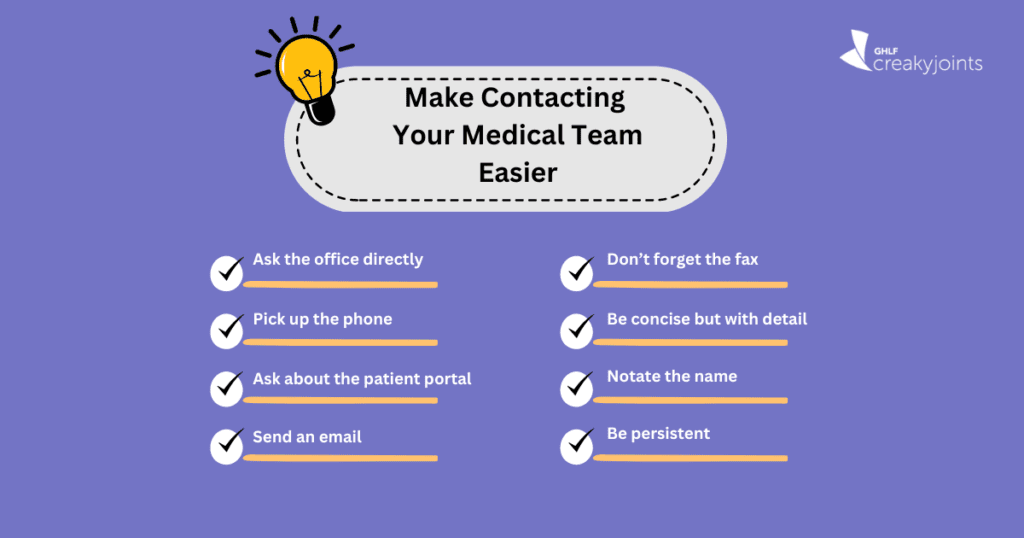Staying in touch with your medical team between face-to-face appointments is essential for managing rheumatoid arthritis (RA) or any inflammatory arthritis. However, this can sometimes be challenging.
If you’re living with RA, like I am, it’s likely you depend on a team of health care providers, often spread across multiple offices, for various aspects of your care. This can include scheduling appointments, managing medications, getting referrals, answering questions, offering education, and even handling financial matters (i.e. copay cards, prior authorizations, and basic billing).
Contacting your medical team between office visits is crucial for keeping your RA under control and maintaining your quality of life. But it’s not always easy. Challenges can arise due to staffing, technology issues, administrative hurdles, office hours, and the complexities of the American health care system.
Despite these obstacles, reaching out to your medical team doesn’t have to feel overwhelming. As a nurse practitioner and someone living with RA, here are my best tips for making this process easier.
Ask the Office Directly
First, ask the office how they prefer to be contacted. Make sure to specify whether you’re trying to reach your medical provider, the nurse line, the front or back office, or billing, as these may have different systems or preferred methods of communication. It sounds simple, and it is.
Pick Up the Phone
Sometimes, the quickest way to contact your medical team is by phone. If you’re able to leave a voicemail, include your full name, date of birth, and a call-back number to help them locate your records more easily.
Ask About the Patient Portal
If your medical team offers a patient portal, be sure to ask about its features. While portals often come with many options, your office may only use certain ones. It’s important to ask who has access to the portal and who reviews the messages you send. For example, the portal might be the best way to contact your provider directly, but not the office staff or billing department.
Send an E-mail
Some offices have e-mail set up, and may prefer this for non-urgent issues. Be sure to ask about this as an option. Again, ask directly who is responsible for checking e-mails, so you know exactly who you’re corresponding with.
Don’t Forget About Fax
Although this is a relatively older technology, electronic faxes are still very popular for privacy and safety reasons, and many medical offices still use this (and actually rely on it heavily). This might be an effective way to share documents and other communications quickly with your medical team.
Be Concise (But with Details)
No matter which method you use to contact your medical team, be sure to include important information and a very brief summary of your question. Try to avoid leaving a message that says “please return my call” without any details. Remember that the people who work in the office treat patients like you every day, so it’s unlikely that the reason you’re calling is truly as private or embarrassing as you may feel it is. Leaving details will speed up the appropriate person returning your call.
Notate the Name
When/if you do speak with someone, be sure to ask their name. It’s always easier to follow up on something if you know the person on-site who was designated to work on it or the person who took your message in the first place.
Try Again
If you reached out yesterday (or the day before or last week) and have not heard back yet, try again. You can try the same method you tried, or try a different method, but polite persistence is key. Sometimes a gentle reminder that you’re waiting for a response is required in busy medical offices. The squeaky wheel gets the grease, after all.
Head Into the Office
Sometimes, phones, e-mails, portals, and faxes get busy with hundreds of daily communications. Unfortunately, your communication may be at the bottom of the list or cue and may take time to reach. You can always stop in the office and ask your question or ask for an update on that signature, form, or prior authorization that you’re waiting for.
Schedule an Appointment
If you have questions about your medical diagnosis, plan of care, or medications that are more than a yes or no answer, ask to schedule an appointment. Face-to-face is likely the most effective way to get questions answered and not lose any important details.
Ask about Telehealth
If you can’t make it into the office to ask your questions, ask about telehealth options. This type of visit is more convenient, and it can often give you enough face-to-face time with your provider to answer your questions. Be sure to check with your insurance about the cost of these visits prior to scheduling so there are no surprises.
The bottom line: Clear communication and polite persistence are usually your best bet when contacting your medical team. If it didn’t work, simply try again.
Be a More Proactive Patient with PatientSpot
Join CreakyJoints’ patient-centered research registry to track your symptoms, disease activity, and medications — and share with your doctor. Sign up.






